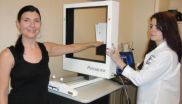(Press-News.org) SAN FRANCISCO – May 28, 2014 – There may be a connection between taking vasodilators and developing early-stage age-related macular degeneration (AMD), the leading cause of vision loss and blindness among Americans who are age 65 and older, according to a study published online in Ophthalmology, the journal of the American Academy of Ophthalmology.
AMD – the deterioration of the eye's macula, which is responsible for the ability to see fine details clearly – affects an estimated 11 million people in the United States. In addition to increased age, the cause of AMD may be attributed to several risk factors, including hereditary risk and smoking. Some studies have also found an association between AMD and high blood pressure, but this has been inconsistent. To help clarify the relationship between AMD incidence and blood pressure lowering medications, including vasodilators, researchers from the University of Wisconsin School of Medicine and Public Health conducted a long-term population-based cohort study from 1988 to 2013 of nearly 5,000 residents of Beaver Dam, Wis., aged 43 to 86 years. The research is part of the National Eye Institute -funded Beaver Dam Eye Study, which has since 1987 collected information on the prevalence and incidence of AMD, macular degeneration and diabetic retinopathy.
The researchers found that, after adjusting for age, sex and other factors, using any vasodilator such as Apresoline and Loniten, which open (dilate) the blood vessels – was associated with a 72 percent greater risk of developing early-stage AMD. Among people who were not taking vasodilators, an estimated 8.2 percent developed signs of early AMD. In comparison, among those taking a vasodilator medication, 19.1 percent developed the disease.
The researchers also found that taking oral beta blockers such as Tenormin and Lopressor was associated with a 71 percent increase in the risk of neovascular AMD, a more advanced and vision-threatening form of the disease. Among those who were not taking oral beta blockers an estimated 0.5 percent developed signs of neovascular AMD. In comparison among those taking oral beta blockers, 1.2 percent developed neovascular AMD.
While the study provides risk estimates of associations between blood pressure lowering medications and AMD at various stages, the researchers caution that their study was not able to discern effects of the medications themselves and the conditions for which participants were taking those medications.
"As significant as these results may be, it's important that they be replicated first, and if possible tested in a clinical trials setting before changing anyone's medication regimens," said Ronald Klein, M.D., MPH, lead researcher of the study. "Further research is needed to determine the cause of these increased risks."
INFORMATION:
For more information about AMD and general eye health, visit the American Academy of Ophthalmology's public education website at http://www.geteyesmart.org.
The May 2014 issue of Ophthalmology, in print now, features a number of new research reports, including:
The Neovascular Age-Related Macular Degeneration Database: Multicenter Study of 92,976 Ranibizumab Injections: Report 1 – Visual Acuity. This study showed that a well-designed electronic medical record system rapidly produces large volumes of high-quality real-world outcome data to model predictors of vision and treatment burden and to facilitate phase 4 and 5 clinical trial designs.
Qualitative and Quantitative Characteristics of Near-Infared Autofluorescence in Diabetic Macular Edema. A mosaic pattern seen on near-infrared autofluorescence images is related to macular thickening, photoreceptor damage, and visual impairment, and eyes with hypofluorescence had increased macular thickness and serous retinal detachment in diabetic macular edema.
Use of Health Care Claims Data to Study Patients with Ophthalmologic Conditions. Analyses of claims data are potentially valuable in examining specific research questions, but these analyses can vary in their methodological rigor. Common advantages and issues are described, and guidance is given for readers to interpret studies properly.
About the American Academy of Ophthalmology
The American Academy of Ophthalmology, headquartered in San Francisco, is the world's largest association of eye physicians and surgeons — Eye M.D.s — with more than 32,000 members worldwide. Eye health care is provided by the three "O's" – ophthalmologists, optometrists, and opticians. It is the ophthalmologist, or Eye M.D., who has the education and training to treat it all: eye diseases, infections and injuries, and perform eye surgery. For more information, visit http://www.aao.org.
About Ophthalmology
Ophthalmology, the official journal of the American Academy of Ophthalmology, publishes original, peer-reviewed, clinically-applicable research. Topics include the results of clinical trials, new diagnostic and surgical techniques, treatment methods, technology assessments, translational science reviews, and editorials. For more information, visit http://www.aaojournal.org.
Some high blood pressure drugs may be associated with increased risk of vision-threatening disease
Major population study finds vasodilators may raise likelihood of age-related macular degeneration
2014-05-28
ELSE PRESS RELEASES FROM THIS DATE:
NYU researchers pilot educational and behavioral program to reduce lymphedema risk
2014-05-28
Viewed as one of the most unfortunate outcomes of breast cancer treatment, lymphedema is characterized by an accumulation of lymph fluid in the interstitial spaces of the affected limb, leading to chronic ipsilateral limb swelling causing psychosocial distress and physical challenges for patients.
Even conservative estimates suggest that 3% of women who have had sentinel lymph node biopsy and 20% of those who have had axillary lymph node dissection may develop lymphedema a year after breast cancer surgery. Two established risk factors for lymphedema are compromised ...
A cure for dry eye could be a blink away
2014-05-28
A treatment for dry eye—a burning, gritty condition that can impair vision and damage the cornea—could some day result from computer simulations that map the way tears move across the surface of the eye.
Kara Maki, assistant professor in Rochester Institute of Technology's School of Mathematical Sciences, contributed to a recent National Science Foundation study seeking to understand the basic motion of tear film traversing the eye. "Tear Film Dynamic with Evaporation, Wetting and Time Dependent Flux boundary Condition on an Eye-shaped Domain," published in the journal ...
Antarctic ice-sheet less stable than previously assumed
2014-05-28
The first evidence for massive and abrupt iceberg calving in Antarctica, dating back 19,000 to 9,000 years ago, has now been documented by an international team of geologists and climate scientists. Their findings are based on analysis of new, long deep sea sediment cores extracted from the region between the Falkland Islands and the Antarctic Peninsula. The study in the May 28, 2014 issue of Nature bears witness to an unstable Antarctic ice sheet that can abruptly reorganize Southern Hemisphere climate and cause rapid global sea level rise.
"One of the iceberg events ...
Filling in the gaps on the protein map
2014-05-28
By cataloging over 18,000 proteins, researchers from TUM have produced an almost complete inventory of the human proteome. This information is now freely available in the ProteomicsDB database, which is a joint development of TUM and software company SAP. The database includes information for example on the types, distribution, and abundance of proteins in various cells and tissues as well as in body fluids.
The investigations show that, on the one hand, around 10,000 proteins are concerned with housekeeping processes in many different places. On the other hand, it was ...
Zeroing in on the proton's magnetic moment
2014-05-28
As part of a series of experiments designed to resolve one of the deepest mysteries of physics today, researchers from RIKEN, in collaboration with the University of Mainz, GSI Darmstadt and the Max Planck Institute for Physics at Heidelberg, have made the most precise ever direct measurement of the magnetic moment of a proton.
The work, published in Nature today, seeks to answer the fundamental question of why we exist at all. It is believed that the Big Bang some 13 billion years ago generated equal amounts of matter and antimatter-which annihilate when they collide-and ...
Extensive cataloging of human proteins uncovers 193 never known to exist
2014-05-28
Striving for the protein equivalent of the Human Genome Project, an international team of researchers has created an initial catalog of the human "proteome," or all of the proteins in the human body. In total, using 30 different human tissues, the team identified proteins encoded by 17,294 genes, which is about 84 percent of all of the genes in the human genome predicted to encode proteins.
In a summary of the effort, to be published May 29 in the journal Nature, the team also reports the identification of 193 novel proteins that came from regions of the genome not predicted ...
New study finds Antarctic Ice Sheet unstable at end of last ice age
2014-05-28
CORVALLIS, Ore. – A new study has found that the Antarctic Ice Sheet began melting about 5,000 years earlier than previously thought coming out of the last ice age – and that shrinkage of the vast ice sheet accelerated during eight distinct episodes, causing rapid sea level rise.
The international study, funded in part by the National Science Foundation, is particularly important coming on the heels of recent studies that suggest destabilization of part of the West Antarctic Ice Sheet has begun.
Results of this latest study are being published this week in the journal ...
Major discovery on the mechanism of drug resistance in leukemia and other cancers
2014-05-28
A mechanism that enables the development of resistance to Acute Myeloid Leukemia (AML) anticancer drugs, thereby leading to relapse, has been identified by Kathy Borden of the University of Montreal's Institute for Research in Immunology and Cancer (IRIC) and her collaborators. Kathy Borden is a Principal Investigator at IRIC and a professor at the university's Department of Pathology and Cell Biology. The development of drug resistance is one of the main problems in clinical oncology and the cause of relapse in many patients.
The new discovery, recently published in ...
NASA's TRMM and Aqua satellites peer into Tropical Storm Amanda
2014-05-28
Hurricane Amanda has weakened to a tropical storm, but not before NASA's TRMM satellite took a look under its clouds at the rate of heavy rainfall it was generating. After weakening to a tropical storm, NASA's Aqua satellite identified that those strong thunderstorms were limited to the area around the center of its circulation.
The Tropical Rainfall Measuring Mission satellite known as TRMM passed over Amanda on Saturday May 24, 2014 at 2150 UTC (5:50 p.m. EDT). TRMM is a joint mission between NASA and the Japan Aerospace Exploration Agency known as JAXA.
At NASA's ...
Wild coho may seek genetic diversity in mate choice
2014-05-28
CORVALLIS, Ore. – A new study by researchers at Oregon State University suggests that wild coho salmon that choose mates with disease-resistant genes different from their own are more likely to produce greater numbers of adult offspring returning to the river some three years later.
The researchers also found that hatchery-reared coho – for some unknown reason – do not appear to have the same ability to select mates that are genetically diverse, which may, in part, explain their comparative lower reproductive success.
Results of the study have been published in this ...
LAST 30 PRESS RELEASES:
Heart-brain connection: international study reveals the role of the vagus nerve in keeping the heart young
Researchers identify Rb1 as a predictive biomarker for a new therapeutic strategy in some breast cancers
Survey reveals ethical gaps slowing AI adoption in pediatric surgery
Stimulant ADHD medications work differently than thought
AI overestimates how smart people are, according to HSE economists
HSE researchers create genome-wide map of quadruplexes
Scientists boost cell "powerhouses" to burn more calories
Automatic label checking: The missing step in making reliable medical AI
Low daily alcohol intake linked to 50% heightened mouth cancer risk in India
American Meteorological Society announces Rick Spinrad as 2026 President-Elect
Biomass-based carbon capture spotlighted in newly released global climate webinar recording
Illuminating invisible nano pollutants: advanced bioimaging tracks the full journey of emerging nanoscale contaminants in living systems
How does age affect recovery from spinal cord injury?
Novel AI tool offers prognosis for patients with head and neck cancer
Fathers’ microplastic exposure tied to their children’s metabolic problems
Research validates laboratory model for studying high-grade serous ovarian cancer
SIR 2026 delivers transformative breakthroughs in minimally invasive medicine to improve patient care
Stem Cell Reports most downloaded papers of 2025 highlight the breadth and impact of stem cell research
Oxford-led study estimates NHS spends around 3% of its primary and secondary care budget on the health impacts of heat and cold in England
A researcher’s long quest leads to a smart composite breakthrough
Urban wild bees act as “microbial sensors” of city health.
New study finds where you live affects recovery after a hip fracture
Forecasting the impact of fully automated vehicle adoption on US road traffic injuries
Alcohol-related hospitalizations from 2016 to 2022
Semaglutide and hospitalizations in patients with obesity and established cardiovascular disease
Researchers ‘listen in’ to embryo-mother interactions during implantation using a culture system replicating the womb lining
How changing your diet could help save the world
How to make AI truly scalable and reliable for real-time traffic assignment?
Beyond fragmented markets: A new framework for efficient and stable ride-pooling
Can shape priors make road perception more reliable for autonomous driving?
[Press-News.org] Some high blood pressure drugs may be associated with increased risk of vision-threatening diseaseMajor population study finds vasodilators may raise likelihood of age-related macular degeneration






